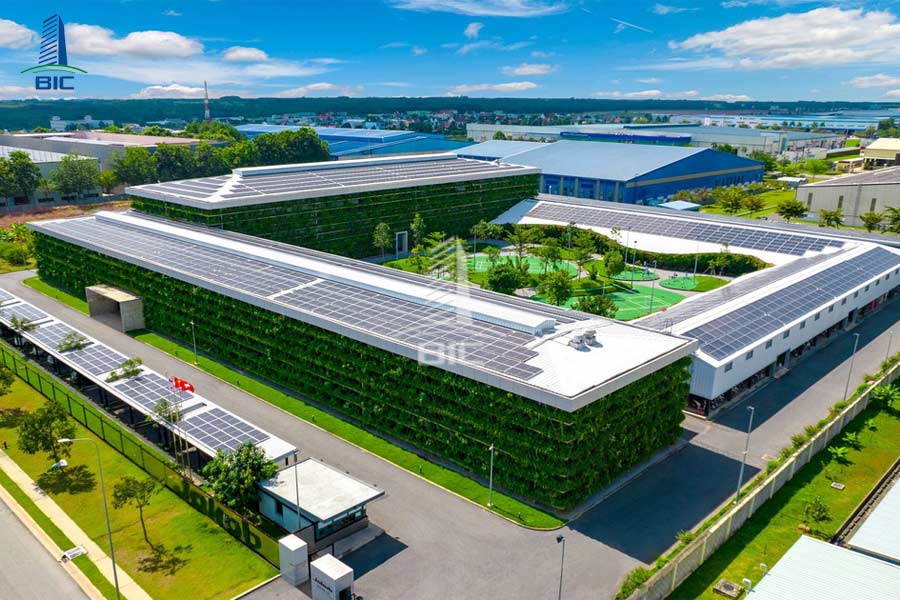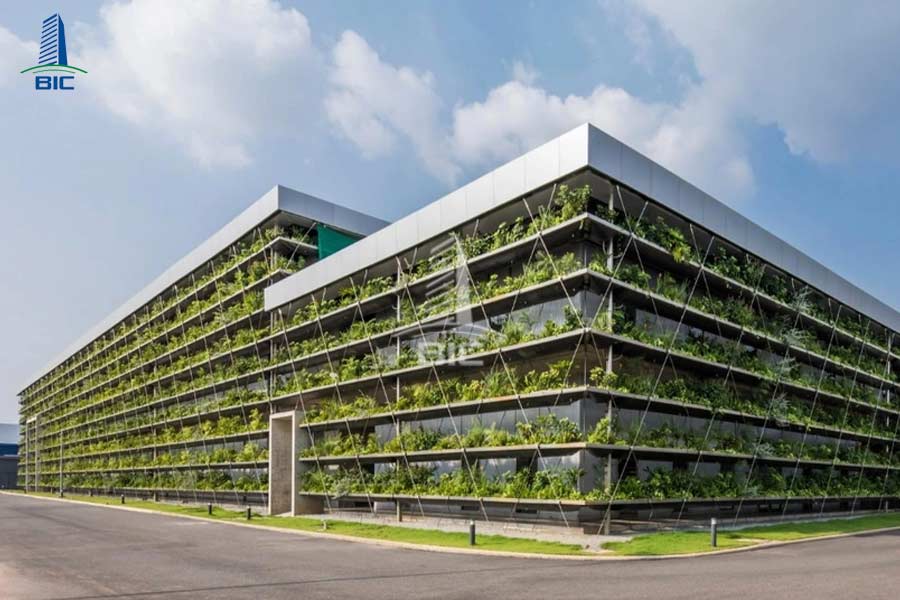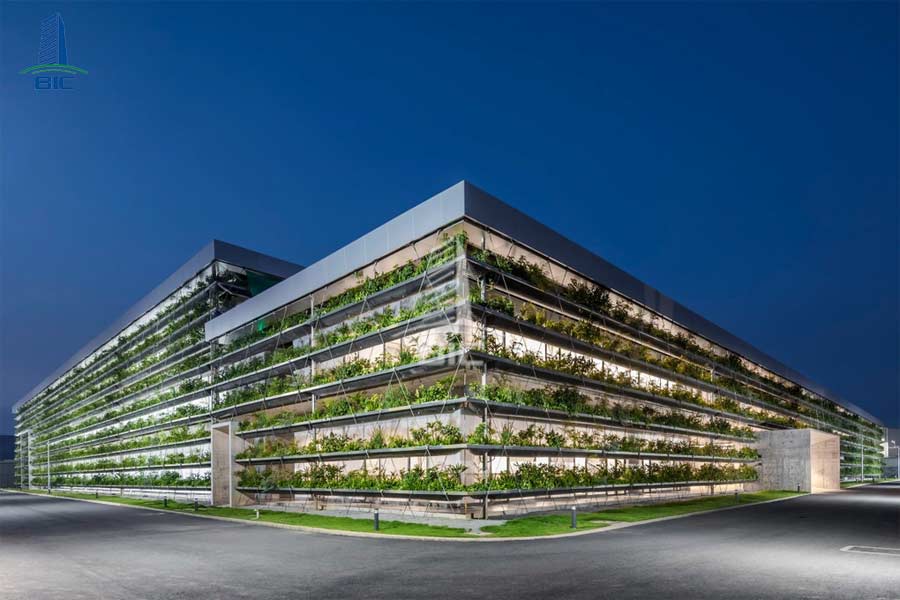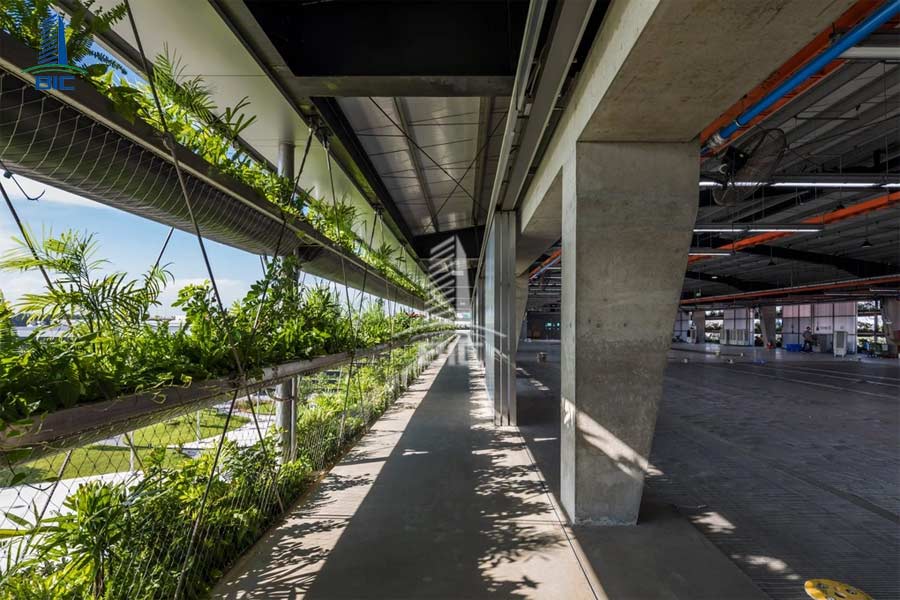
Green trends are becoming a focal point across various sectors, from agriculture and transportation to industry and urban development. In the construction sector, going green is not only a response to climate change but also a sustainable development strategy that helps save energy and improve quality of life. In Vietnam, more and more projects are embracing green building standards especially in construction and industrial factory design where balancing functionality, cost, and environmental impact is crucial. In this article, BIC analyzes this trend and highlights the benefits it brings to businesses and society.
Green construction involves applying advanced technical solutions to minimize negative environmental impact while improving energy efficiency, resource use, and operational optimization. From design to construction and operation, green building focuses on long-term sustainability, cost savings, and health protection for occupants.
It’s important to distinguish between going green and merely cutting costs:
- Cost-saving usually emphasizes reducing initial investment, sometimes leading to the use of cheap materials or short-term construction methods.
- Green construction, on the other hand, focuses on eco-friendly designs and materials to reduce energy consumption, save resources, and prolong building lifespan.
Although upfront costs may be higher, green construction delivers long-term economic efficiency through lower operating and maintenance expenses, along with improved living quality.

To promote green development, many projects in Vietnam aim for prestigious green certification systems such as:
- LOTUS – Developed by the Vietnam Green Building Council (VGBC), tailored to the local climate.
- EDGE – Focused on optimizing energy, water, and material efficiency.
- LEED – A globally recognized international green building certification.
Applying these standards encourages the use of green materials in industrial factory design, office towers, and other types of buildings.
The green trend is becoming a necessary direction in modern construction, not only for environmental reasons but also for the lasting value and sustainability it brings. When properly implemented, green building strikes a balance between economic efficiency, social responsibility, and improved quality of life something traditional buildings often struggle to achieve.
Integrating green solutions in the design phase significantly reduces emissions, fossil fuel use, and overexploitation of natural resources. Systems such as natural lighting, cross-ventilation, and thermal insulation not only save energy but also minimize the building's environmental footprint.
Green buildings offer competitive advantages. Property value increases not only due to quality construction but also because of brand prestige associated with green certifications like LEED, EDGE, and LOTUS. More importantly, operational and maintenance costs are optimized especially crucial for energy-efficient factory projects with large and continuous energy and water demands.

Sustainable buildings provide airy, comfortable environments that reduce exposure to pollution and harmful substances. For production spaces and offices, this leads to higher employee productivity and morale an intangible but vital value.
Green building is not a trend of the moment but a long-term strategy benefiting the environment, investors, and users alike. Integrating green thinking from the early stages especially in factory and urban planning will increasingly become standard practice.
Vietnam’s green building movement is spreading not just in major urban areas but also in industrial zones, factories, and infrastructure projects. Key trends shaping sustainable and environmentally friendly design include:
The first shift comes from the very materials used in construction. Unfired bricks, lightweight concrete, VOC-free paints, and recycled wood are gradually replacing traditional materials. These alternatives reduce CO₂ emissions during production and support green building practices that minimize pollution and enhance living quality.
In factory design, choosing materials with good thermal insulation and low dust emission is essential to meet new environmental standards.
Modern buildings increasingly leverage natural elements to reduce dependency on artificial energy. Natural lighting is maximized through windows and skylights; airflow is optimized via cross-ventilation, lessening the load on cooling systems.
In energy-efficient factory design, this is a core strategy for lowering operational costs and boosting productivity. Features like insulated roofs, heat-reflective coatings, and efficient space planning are actively adopted by architects.

Digital integration is ushering in a new era in construction. BIM (Building Information Modeling) allows complete lifecycle simulation from the design stage. IoT systems monitor energy usage, while solar panels and on-site wastewater treatment ease the burden on urban infrastructure.
These elements form the foundation for a sustainable, smart, and flexible construction ecosystem aligned with green industrial development goals.
Green spaces are becoming integral to modern buildings even in seemingly utilitarian structures like factories or logistics hubs. Gardens, vertical greenery, skylights, and green roofs are all planned to balance aesthetics, microclimate, and function.
Incorporating landscaping in factory design enhances corporate image while improving the work environment, reducing stress, and increasing worker productivity.
Despite growing recognition of its value, applying green practices in Vietnam still faces several barriers including technical, regulatory, financial, and awareness challenges.
Many investors and contractors still see green solutions as "added value" rather than essential requirements. As a result, green buildings are mostly limited to large or public projects, while most residential and industrial buildings continue to prioritize low cost and fast construction.
One of the main obstacles is the upfront cost of implementing green solutions from materials and technical systems to design consulting. For budget-constrained businesses, especially in factory design, this makes them hesitant to invest in energy-saving or wastewater treatment systems.
However, these costs should be viewed in the context of long-term gains lower maintenance, operational savings, and enhanced brand value.
Vietnam’s green design expertise is still developing. Few firms have real-world experience with certifications like LEED, LOTUS, or EDGE. This limits the ability to offer tailored solutions for different project types especially technical projects like energy-efficient factories.

While the Vietnamese government has outlined green building development goals, incentives such as financial aid, tax breaks, or green loans remain fragmented and hard to access. The lack of a clear legal framework also makes it difficult for businesses to implement and receive official recognition for green projects.
To effectively implement green practices, design firms play a pivotal role not just as solution providers but as the bridge between sustainable goals and practical execution.
A professional design firm can help investors assess climate conditions, sunlight and wind directions, building functions, and long-term operating costs. They then propose tailored green design solutions—without unnecessary duplication or waste.
In industrial factory design, the designer’s role is even more crucial, as it involves balancing functionality, cost, and environmental performance. Decisions on insulation materials, layout planning, natural ventilation, and solar installation must be made early on to avoid costly upgrades later.
Beyond being mere designers, green pioneers also serve as trendsetters and long-term partners, guiding businesses throughout the building lifecycle from design construction to operation.
Green building is no longer a luxury concept or something reserved for premium developments. In Vietnam, it is becoming the new standard especially for large-scale projects like industrial zones, factories, logistics centers, and office towers.
As a leading construction and industrial design firm committed to green technology, BIC proudly partners with businesses to create sustainable, efficient, and eco-friendly buildings from the ground up.